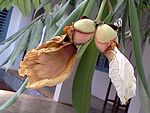Nagkesar seed oil
This articleneeds additional citations forverification.(April 2019) |





Nagkesar oilis extracted from seeds of the nagkesar tree (Mesua ferrea,Hindi:नागकेसर). It belongs to theCalophyllaceaefamily. It is an East Indianevergreen treeand is often planted as anornamentalfor its fragrant white flowers that yield aperfume.It is the source ofhardwoodused forrailroad ties.[1]It is Sri Lanka's national tree.[2]
Etymology[edit]
The generic name is after J. Mesue (777–857) and the specific epithet is from Latin, meaning 'belonging to iron', in reference to its famed and very hard, durable timber.[3]
Common names[edit]
It is commonly known as Ceylon ironwood, cobra's saffron, Indian rose chestnut, ironwood tree, mesua, poached egg tree[2][unreliable source?]
Common names in India[edit]
- Hindi− नाग चम्पा (Nag champa, नागकेसर( Nagkesar )
- Urdu− नर्मिश्क, Narmishka
- Tamil− Tadinangu, நாகப்பூ( nagappu), நாகேசுரம் (nakecuram)
- Marathi− Thorlachampa, नागचंपा (nagchampa), नागकेशर (nagakeshara)
- Malayalam− (Vainavu, ചുരുളി (churuli
- Assam− নোক্তে (Nokte ), নাহৰ (Nahor), নাগেশ্বৰ (Nageshwar)
- Meitei− নাগেসৰ (Nageshor )
- Telugu−నాగకేసరము (nagakesaramu)
- Sanskritनागकेशर (nagakesarah), नागपुष्प( nagapuspah)
- Kannada− ನಾಗ ಕೇಸರಿ( nagakesari), ನಾಗ ಸಮ್ಪಿಗೆ (nagasampige)
- Bengali− নাগকেশর (nagkesar, পুন্নাগ (punnaga)
- Gujarati− નાગચંપા( nagachampa)
- Kashmiri− नागकेसर (nagkesarah)
Common name in other countries[edit]
- English− Ceylon ironwood, Cobra's saffron, Indian rose-chestnut, Iron-wood tree, Sembawang tree (Singapore)
- Italian− Croco di cobra
- German− Nagassamen
- Arabic− Narae-kaisar
- Russian− Indiiskoe zheleznoe derevo, Mezua zheleznaia, Mezuia zheleznaia, Nagakeshara (from Hindi), Zheleznoe derevo.
- Burmese− Gungen, Kenga
- Chinese-: Tie li mu, (Taiwan)
- Japanese− Tagayasan
- Thai-: Bhra na kaw, Bunnak (Boon naak), Ka ko (Karen), Gaa gaaw, Gam gaaw, Kam ko (Shan), Saan phee daawy, Saraphi doi (Chiang Mai)
Habitat[edit]
M. ferreareaches up to 100 feet (30 m) height.The tree is native toSri Lanka,India,southern Nepal,Burma,Thailand,Indochina, thePhilippines,MalaysiaandSumatra,where it grows in evergreen forests, especially in river valleys. In the Himalayas and India the tree can grow at altitudes up to 1,500 m (4,900 ft) and in Sri Lanka up to 1,000 m (3,300 ft).[4]It is the onlyironwoodforest in the dry zone with wet zone vegetation.
Morphology[edit]
Tree[edit]
M. ferreais a small to medium-sizeevergreenIt grows up to 13 m (43 ft) tall, often buttressed at the base with atrunkup to 90 cm (35 in) indiameter.It has simple, narrow,oblong,dark greenleaves7–15 cm (2.8–5.9 in) long, with a whitish underside. The emerging young leaves are red to yellowishpinkand droop.[2]Thewoodis hard, heavy and strong at about 72 pounds per cubic foot (1.15 g/cm3). Its density is 1.12 ton/m3.[citation needed]
Flowers[edit]
Its flowers are terminal or axillary,bisexual,solitary or in an up to nine-flowered openpanicle,pedicelwith small pairedbracts.It has fourdecussatesepalssub-orbicular, persistent and variously enlarged and thickened in fruit.Stamensare numerous, free orconnateonly at the base,ovarysuperior (1-2 celled) each cell with one to two axillaryovules.They are slender with apeltateto four-lobed stigma. The flowers are 4–7.5 cm (1.6–3.0 in) diameter, with four whitepetals.[3]The flowers are used to make anincenseand to stuffpillows.[2]
Fruits[edit]
The fruit is a capsule, usually globule, often beaked, thinly woody, usually dehiscing with two to four valves before falling, often exuding resinous droplets. One fruit contains one to four seeds. Fruits are reddish, conical hard and ovoid. The fruit diameter is 3.0 "and nearly woody. Fruits are ovoid, 2.5–5 cm (1.0–2.0 in) long with persistentcalyx.The seeds are dark brown fleshy oilycotyledons.[5][unreliable source?]Fruits weigh from 50–60 g (1.8–2.1 oz) each.[6]
Seeds[edit]
The fruit contains one round or three conical brown, shiny, seeds consisting of the kernel (cotyledons, 36.6%) within a fibrous outer cover (50% seed) and brittle shell (13.4%).M. ferreaseeds containedlipids(66.91-70.23 g %), moisture (4.02-5.05 g %), ash (1.46-1.50 g %), total protein (6.99-7.19 g %), water-soluble protein (2.98-3.11 g %), starch (5.51-5.85 g %), crude fiber (1.22-1.98 g %), carbohydrate (15.88-18.68 g %). The energy value is 700.55-724.15 kcal/100 g.[7]
Physical properties and composition[edit]
The major fatty acids in nagkesar oil areoleic acid,linoleic acid,stearic acid,andpalmitic acid.Polyphenolsand volatiles can contribute an unpleasant odour. These include the 4-phenylcoumarinsmesuol, mammeisin, mesuagin and mammeigin.[8]
| Fatty acid | percentage |
|---|---|
| Myristic acid(C14:0) | 0.0-2.8 |
| Palmitic acid(C16:0) | 8.0-16.5 |
| Stearic acid(C18:0) | 10.0-15.8 |
| Oleic acid(C18:1) | 55-66 |
| Linoleic acid(C20:0) | 0-1.0 |
| Character | Range/limit |
|---|---|
| Refractive Indexat,400C | 1.465-1.475 |
| Iodine value | 65-95 |
| Saponification value | 195-205 |
| Moisture | 1.0-1.5 |
| Color 1/4 "cell(Y+5R) | 25-35 |
| Unsaponifiable matter% | 2.0-2.5 |
See also[edit]
References[edit]
- ^"ironwood tree - definition of ironwood tree by the Free Online Dictionary, Thesaurus and Encyclopedia".Thefreedictionary.Retrieved2013-11-21.
- ^abcd"Mesua ferrea - Nag Kesar".Flowersofindia.net.Retrieved2013-11-21.
- ^ab"Species Information".Worldagroforestry.org.Retrieved2013-11-21.
- ^"Mesua ferrea: Useful and graceful tree | Forest Research Institute Malaysia".frim.gov.my.Archived fromthe originalon 9 November 2013.Retrieved2 February2022.
- ^Chakrapani Ayurveda."Nagkesar, Mesua, Mesua ferrea, Clusiaceae".Nagkesar.Retrieved2013-11-21.
- ^abSEA HandBook-2009, By The Solvent Extractors' Association of India[full citation needed]
- ^abcAbu Sayeed, M.; Abbas Ali, M.; Sohel, F.I.; Astaq Mohal Khan, G.R.M.; Sarmina Yeasmin, Mst. (2004)."Physico-chemical characteristics ofMesua ferreaseed oil and nutritional composition of its seed and leaves".Bulletin of the Chemical Society of Ethiopia.18(2). Ajol.info.doi:10.4314/bcse.v18i2.61435.
- ^BALA, K.R.; T.R. SESHADRI (1971). "Isolation and synthesis of some coumarin components of Mesua ferrea seed oil".Phytochemistry.10(5): 1131–1134.Bibcode:1971PChem..10.1131B.doi:10.1016/s0031-9422(00)89951-3.
- ^PHYSICO-CHEMICAL CHARACTERISTICS OF MESUA FERREA SEED OIL AND NUTRITIONAL COMPOSITION OF ITS SEED AND LEAVES.M. Abu Sayeed, M. Abbas Ali, F.I. Sohel, G.R.M. Astaq Mohal Khan and Mst. Sarmina Yeasmin
